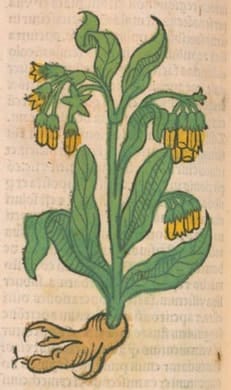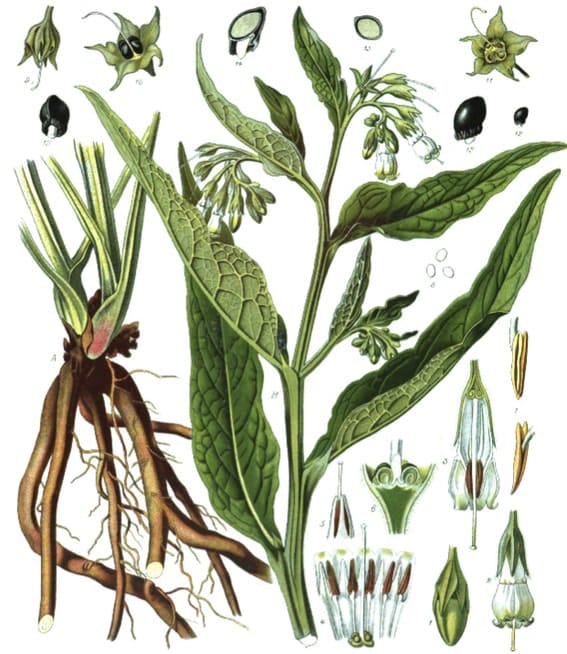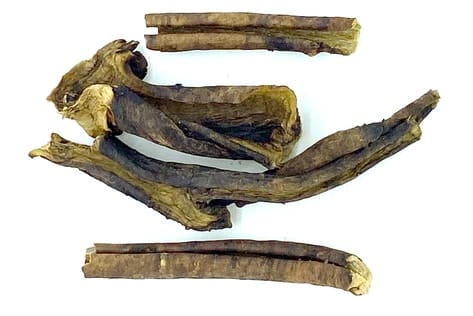Symphytum, ComfreyConsolida Major |

|

|
 Ortus Sanitatis, Meydenbach, 1491
Ortus Sanitatis, Meydenbach, 1491 Koehler’s Medizinal Pflanzen, 1887
Koehler’s Medizinal Pflanzen, 1887 Comfrey root (Adam, 2022)
Comfrey root (Adam, 2022)Botanical name:
Symphytum officinale
Other related species such as the Russian Comfrey (Symphytum x uplandicum) and Prickly Comfrey (S. asperum) have been used, but these should be avoided due to the higher levels of toxic alkaloids.
Parts used:
Root; Leaf
Temperature & Taste:
Cool, neutral in respect of moisture (some said Temperate). Sweet, Bitter
Classifications:
2C INCIDERS. 2D ATTENUATERS OF CONGEALED BLOOD. 2L. EMOLLIENT. 2O. ASTRINGENT. 2P. HEMOSTATIC. 2T. GLUTINATE
2W. SARCOTIC. 2X. INCARNATIVE
3L. ANTI-TUSSIVE. 3M. ARTHRITIC
4f. SPLENETIC. 4k. ARTHRITIC
TCM:
B. Clears Heat, Cools the Blood B. Clears Deficient Heat
Uses:
1. Nourishes the Yin, Strengthens the Kidneys and Bones:
–strengthens the back in Lumbago: ‘against the pain in the back gotten by any violent motion as wrestling, or overmuch use of women doth in 4 or 5 days perfectly cure the same’ (Gerard)
-lower back and knee weakness; chronic back pain and acute back strain
-Ulcers of the kidneys, Nephritis.
-Fractures. injuries, degeneration to the bones and joints, for which it was considered by many to be a specific.
-Tendonitis, Arthritis, Gout and Rheumatism etc.
-Diabetes
2. Clears Heat, Stops Bleeding and Leakages:
-bleeding from heat, such as Hematuria, spitting of Blood, Excessive or profuse Menstruation, and Irregular Uterine Bleeding.
-Ulcerative Colitis, Diarrhea, Dysentery, and Leukorrhea, with or without blood;
3. Clears Heat, Nourishes Yin, Promotes Healing:
-tidal or hectic fevers with dry throat, and a rapid but faint pulse.
-internally and externally for all Ulcers including those of the Stomach, Bowels, Lungs, Vagina etc.
-special for internal and external Ulcers.
-‘it prevails much against Ruptures and Burstings’, and is therefore used for Hernias and Aneurisms.
4. Nourishes the Blood:
-strengthens the Blood, and helps increase circulation. By nourishing Yin and Blood, it is useful in a variety of chronic diseases.
5. Clears Heat and Phlegm, Stops Coughs:
–Gerard said ‘the roots boiled and drunk, do cleanse the breast, and cure griefs of the Lungs, especially if they be confected’
-irritable coughs, Bronchitis, Laryngitis, Whooping Cough, Pneumonia
-Tuberculosis, Emphysema, Lung Ulcers
-smokers coughs. Relieves Tobacco craving; the root is chewed.
-Catarrhal conditions of any other mucous membrane
6. Clears Heat, Moves the Blood, Resolves Masses:
-‘separates clotted Blood’. (Lonicerus, Krauterbuch, 1564)
–Scrofulous diseases from Phlegm and Heat; Lymphadenitis, swollen Lymph nodes
-Tumors; Cancer (including Lung, Stomach, Bowels etc.)
7. Externally:
-all Trauma, Wounds, Bruises, Fractures
-Ulcers: ‘In ulcerative conditions and burns its utility is confirmed by numerous observers’ (Lancet, 1912); its external use for Ulcers was accepted as the main indication by the German Commission E; used for Varicose Veins, Varicose Ulcers, slow and chronic suppurating Ulcers (especially of the Leg), and Gangrenous Ulcers
-‘Running Sores’ and ‘Rodent Ulcers’ (Basal Cell Carcinoma).
-Burns and Scalds
-acute and chronic inflammations including Mastitis from milk obstruction.
-injured or inflamed Periosteum.
-topically for Gout .
-The tincture relieves neuralgic pains, especially facial neuralgia.
-An old European remedy for Scars, and is said to regenerate aging skin.
-Traditionally used for vaginal tears associated with Birth.
-Gum pain, inflammation and wounds such as after dental surgery.
–“If the herb, together with the root, is boiling in the water for a bath, and the young widows are bathing in it, they will be the same as the virgins.’ (Zwinger, Theatrum botanicum, 1696)
-‘Searle (The British Medical Journal, 1912, June), reports of a 83-year-old arteriosclerotic patient, in whom the entire metatarsal bones had been exposed by a spongy, rapidly growing ulcer. The ulcer defied any clinical treatment and was only cured at home by the application of comfrey’.
Dose:
Root in Decoction: 3–6 grams daily
Leaf in Infusion: 2–4 grams
Root in Powder: 1–2 grams, twice daily
Commonly used externally in fomentations, plasters, oils etc.
Substitute:
1. The root has the ‘same virtues as Marshmallow’ (Madame Young’s Guide to Health, 1858)
2. Rehmannia Sheng Di Huang has similar effects, but doesnt contain the potentially toxic alkaloids.
Main Combinations:
Comfrey & Plantain
Licorice & Comfrey
Bleeding
1. Bleeding:
i. Comfrey root with Licorice root (Formulaire Pharmaceutitique a l’usage des Hospitaux Militaires de France, 1821)
ii. Hemoptysis and other types of Bleeding from Heat, Comfrey with Plantain leaf (as in Syrup of Plantain and Comfrey)
iii. Comfrey root with Solomans Seal, Plantain, Yarrow, Shepherd’s Purse, Raisins (as in Astringent Ale)
iv. Comfrey root with Nettle root, Yarrow, Plantain, Pomegranate peel, Gum Arabic, Poppy seed (as in Styptic Decoction)
v. Powdered Brick (1 oz.), Tragacanth, Gum Arabic (½ oz. each), Comfrey root (6 drams), Betony (2 ½ drams). Mix. (Niemann)
vi. Comfrey, Pomegranate rind, Sumac, Dragons Blood, Armenian Earth, Rose, Tabasheer, Gum Arabic torrefied (as in Pilulae Styptica of Arnold de Villa Nova)
vii. Comfrey with Armenian Earth, Plantain seed, Gypsum, Dragons Blood, Frankincense, Aloe, Tragacanth (as in Pulvis adstrictuus major)
viii. Excess Menstrual bleeding, Comfrey with Tormentil, Sorrel, Tragacanth, Plantain (Antidotarium medico chymicum reformatum 1620)
Trauma, Wounds
2. Wounds, Trauma, Bruising, and Internal Bleeding:
i. Comfrey with Betony, Plantain, Burnet, Coltsfoot
ii. Comfrey root, Pomegranate peel, Aloeswood, Myrrh, Mastic, Dragons Blood, Honey (Fioravantus)
iii. Comfrey, Mullein, Calendula, Camomile externally
iv. oil for external use, Comfrey, St. Johns wort, Calendula
3. Vulnerary formulas for Wounds and Trauma:
i. Comfrey with Tormentil, Sanicle, Vervain, St. John’s wort, Centaury, Shilajit (as in Universal Vulnerary Decoction from Pharmacopoea Dogmaticum Resititua, 1622)
ii. Comfrey with Rue, Hyssop, Sage, Yarrow, Self Heal, Vervain, Agrimony, Angelica (as in Ungent Contra Casum)
4. Plaster for Fractures:
i. seethe Fenugreek and add pulp of Comfrey root to be applied on a cloth; it will dry hard.
ii. Comfrey root, Queen of the Meadow, Armenian Earth, form a plaster with Wax, Resin and Turpentine. (Pharmacopoeia Wirtembergica, 1798)
5. Internally for Fractures, put Comfrey and Pepper in Wine with Honey and take for 9 days. (Physicians of Myddvai)
Ulcers
6. Bladder or Kidney Ulcers, Comfrey root, Soloman’s Seal, Bistort, Ladies Mantle, Plantain, taken with Hydromel (Pharmacopoea Dogmaticum Resititua, 1622)
7. Stomach Ulcers:
i. Comfrey root with Calendula and Knotgrass
ii. Comfrey root with Knotgrass, Plantain, Sanicle, Calendula (Becker)
8. Lung Ulcer, Comfrey root (1 oz.), Tragacanth Cooling Powder (2 scruples), Conserve of Rose, Mastic, Nutmeg, Storax, Frankincense (1 scruple each). With Diascordium (or another suitable Electuary, or Honey), form an Electuary. (Gazophylacium Medico-Physicum, Woyts, 1746)
9. Liver Ulcers, Comfrey with Licorice, Senna, Rhubarb, Poppy seed, Aniseed, Asarum (as in Troches for Liver Ulcers of Andromachus)
Hernias
10. Hernias:
i. Comfrey root with Ladies Mantle
ii. Comfrey root with Soloman’s Seal, Aniseed
iii. Comfrey root with Calamus, Soloman’s Seal, Horsetail, Cyperus nuts, Mastic (Wirtzung)
iv. Comfrey root with Marshmallow root, Mistletoe, Clowns Woundwort (Stachys palaustris)
v. Comfrey with Rupturewort, Rose hip, Tabasheer, Sealed Earth, Fennel (as in Powder for Hernia)
vi. Comfrey, Valerian, Shilajit, Coriander prepared
vii. Take Conserve of Comfrey with Diatragacanth and Diacyminum and Valerian
11. Plaster for Hernia:
i. Venice Turpentine, Mastic, Myrrh, Olibanum, Dragons Blood, Comfrey root, form a plaster with Wax. (Pharmacopoeia Wirtembergica, 1798)
ii. Mastic, Myrrh, Olibanum, Comfrey, Alum, Hematite, form a plaster with Wax and Turpentine. (Pharmacopoeia Generalis, 1783)
Lungs
12. To strengthen the Lungs:
i. Comfrey root with Elecampane, Licorice and Coltsfoot
ii. Comfrey, Raisins, Almonds, Licorice
13. Whooping Cough:
i. fresh Lungwort leaf (4 handfuls), Comfrey, Raisins (2 oz. each), Licorice (3 oz.), Water (2 lbs.). Boil to 1 ½ pounds, strain, and add White Sugar (24 oz.). Boil for a few minutes. (Nouveau Formulaire Medicale et Pharmaceutique, 1820)
ii. Comfrey leaf, Thyme, Plantain, Licorice
14. Consumption:
i. Comfrey, Plantain, Licorice, Marshmallow
ii. Comfrey, Guaiacum, Golden Rod, Plantain, Raisins, Jujube, Licorice (as in Potio pro Phthisicis)
iii. Comfrey, Soloman’s Seal, Dates, Almond, Licorice, Aniseed
Astringent
15. Diarrhea, Dysentery:
i. Comfrey root (2 parts), Tormentil (1 part) in decoction
ii. Comfrey with Pomegranate peel, Dragons Blood, Armenian Earth, Galls, Cinnamon, Mastic, Gum Arabic (as in Pilulae Contra Fluxum of Nicolas)
iii. Comfrey with Galls, Erica seed (as in Pilulae ad dysentericos Asclepiadis)
16. Mucous Colitis, Comfrey leaf, Agrimony, Marshmallow leaf, Cranesbill (Wonder in Weeds)
17. Leukorrhea:
i. Comfrey root with Solomans Seal, Camomile, Gentian
ii. Comfrey root with Elecampane, Horehound
18. Excessive Menstruation:
i. Comfrey, Tormentil, Bistort root (½ oz. each), Chicken broth (2 lbs.). Boil down to half. Take cold. (Nouveau Formulaire Medicale et Pharmaceutique, 1820)
Other
19. Cancer, Freshwater Crayfish (10), Birthwort root (½ oz.), Comfrey root (1 oz.), Agrimony, Ladies Mantle, Betony, Bugle, Sanicle (1 handful each). Decoct in Water and Wine, sweeten with Syrup of Maidenhair and take 6 oz., twice daily. (Gazophylacium Medico-Physicum, Woyts, 1746)
20. Varicocele, Comfrey with Balmony and Rupturewort (The Medical Herbalist)
21. Gonorrhea, Comfrey root (3 oz.), Burdock root (4 oz.), Rose, Willow, Yarrow (2 oz. each), Parsley (1 oz.). Boil in 4 quarts Water and 1 quart Milk down to 3 quarts. Sweeten. A gill (quarter pint) taken 3 times a day will cure acute Gonorrhea in a few days when used with a Tormentil injection. (Madame Young’s Guide to Health, 1858)
22. Emollient Gargle, decoct Comfrey root with Figs (Dispensatorium Fuldense, 1791)
23. Postpartum pain:
i. Comfrey with Amber, Peach kernel and Nutmeg
ii. Comfrey with Meu Asthmaicum, Amber, Orange peel, Saffron, Coriander seed
24. Dryness of the mouth, decoct with Licorice and use as a mouth wash.
25. Weakness or Laxatity of the joints:
i. boil Comfrey with Bran and Vinegar and apply
ii. Weak or Lax Joints, Comfrey, Soloman’s Seal, Yarrow, Mugwort, make an ointment with fresh Butter or animal Fat. (Madame Young’s Guide to Health, 1858)
26. Back Pain, Comfrey, Knotgrass, Shepherd’s Purse (equal parts), decoct in broth. (Natura exenterata, Philiatros, 1655)
Major Formulas:
Infusion for Hernia (Wirtzung)
Decoction of Comfrey and Solomans Seal
Decoction of Timaei (modified)
Decoction to Strengthen the Lungs
Decoction for Excessive Menstruation
Universal Vulnerary Decoction (Joseph Du Chesne)
Styptic Decoction
Syrup of Plantain and Comfrey (Boyles Syrup)
Syrup of Comfrey Compound
Wine for Incontinence
Electuary of Comfrey (Fioravantus)
Powder for Bleeding of Galen
Powder for Bruises (Lemery)
Powder for After-pains (Midwife to the Queen of France)
Powder for After-pains (Lemery)
Powder for Hernia (Pharmacopoeia Extemporanea)
Powder for Trauma
Powder to Break Blood Above and Below (Nicholas)
Pills Against Fluxes (Nicolas)
Styptic Pills
1. Vulnerary Spirit:
i. Comfrey root, herbs of Comfrey, Mugwort, Bugle (4 handfuls each), Betony, Ox-eye Daisy, Bugle, Figwort, Plantain, Agrimony, Vervain, Wormwood, Fennel (2 handfuls each), St. Johns wort, Birthwort, Lesser Houseleek, Veronica, Lesser Centaury, Yarrow, Tobacco, Mint, Hyssop (1 handful each). White Wine (144 oz.). Infuse 3 days, distil two-thirds. (Pharmacopoeia Generalis, 1783)
ii. Comfrey root, Herbs of Comfrey, Bugle, Sanicle, Betony, Figwort, Plantain, Agrimony, St. Johns wort, Periwinkle, Ground Ivy, Mugwort, Veronica, Vervain, Lesser Houseleek, Yarrow (4 oz. each), Sage, Angelica, Tansy, Wormwood, Celandine, Fennel, Clematis, Mint, Hyssop, Tobacco (8 oz. each), Rue, Camomile, Scordium, Marjoram, Rosemary (4 oz. each), Lavender, Oregano, Calamint (6 oz. each). White Wine (50 lbs.) Distil half. (Pharmacopoeia Wirtembergica, 1798)
Cautions:
1. Not used during Pregnancy or while breastfeeding
2. Toxic in overdose or long-term use. Should not be used in those with Liver disease.
Comfrey, like other Pyrrolizidine-alkaloid (PA) containing plants has become controversial and its internal use is banned in a number of countries. In parts of Europe, Comfrey has been traditionally eaten as a food where there are reportedly no greater incidences of Liver disease. However, research has demonstrated potential Hepatotoxic effects. In general, Comfrey is traditionally used for short periods of time, especially as a wound herb. In these cases, use for 2–3 weeks should pose no risk. However, it is best avoided in the very young, elderly, while pregnant and breastfeeding, and in those with Liver disease. Its topical use is regarded as safe.
According to Hoffman, “Between 85% and 97% of the PAs in Symphytum officinale (True/Common) commonly grown in American gardens are built around the less toxic retronecine monoester. However, Russian comfrey (Symphytum peregrinum), contains higher levels of the diester, which, is known to have a greater toxicity.” (See here). Further, echimidine is the most toxic PA in comfrey species and is found in higher amounts in Russian and Prickly Comfrey, not S. officinalis.
It is also important to note that toxic alkaloids are found in higher amounts in the root, therefore making the leaf a safer option for internal use.
An exhaustive review of literature found 8 suspected cases of adverse events from oral intake of Comfrey. However, as the authors noted, other factors such as medication taken simultaneously or incorrect identification could not be ruled out. The authors stated “Based on these case reports, the evidence of harm caused by these plants is weak.” (see here)
Toxicity:
–Oral toxicity study of certain plant extracts containing pyrrolizidine alkaloids
–The comparative toxicity of a reduced, crude comfrey (Symphytum officinale) alkaloid extract and the pure, comfrey-derived pyrrolizidine alkaloids, lycopsamine and intermedine in chicks (Gallus gallus domesticus).
–Metabolism, genotoxicity, and carcinogenicity of comfrey.
–Hepatotoxicity of Pyrrolizidine Alkaloid Compound Intermedine: Comparison with Other Pyrrolizidine Alkaloids and Its Toxicological Mechanism
–Safety of medicinal comfrey cream preparations (Symphytum officinale s.l.): The pyrrolizidine alkaloid lycopsamine is poorly absorbed through human skin.
Main Preparations used:
Distilled Water, Conserves of the Flower, Conserve of the Root, Candied Root, Syrup of the Root, Extract of Comfrey (including the ‘Bloody Extract’), Powder, Decoction and Mucilage
1. Conserve of Comfrey root:
i. Take Comfrey root, peel, slice and boil in water until it can be pulped with the fingers. Pound in a mortar and force through a sieve. Add double its weight of White Sugar and boil over a slow fire, stirring constantly. (Pharmacopoeia Sardoa, 1773)
2. Mucilage of Comfrey:
i. Comfrey root (1 lb.), Boiling Water (4 lbs.). Macerate until the water is thick, strain with slight expression. (Pharmacopoeia Sardoa, 1773)
- Extra Info
- Research
